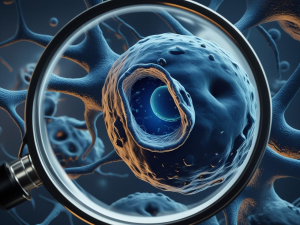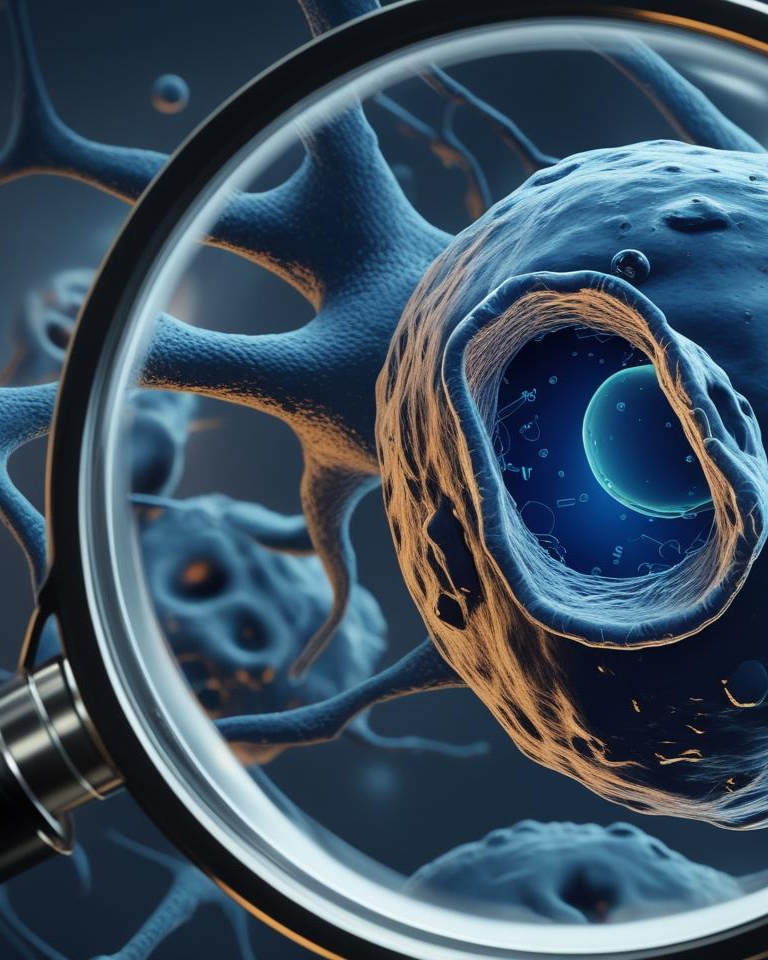Scientifically Based.
Clearly Explained.
Focus: Oxythiamine
This website provides information on the role of a key molecular mechanism that plays a central role in malignant diseases such as cancer, sepsis and viral, bacterial, mycotic and parasitic infections.
When cell division becomes a threat – and research seeks new answers
Uncontrolled cell proliferation is a basic mechanism of many diseases – from cancer to sepsis. The molecule oxythiamine is being investigated as a possible inhibitor of a central enzyme in cell division. This platform explains the underlying mechanisms.
Introduction
When Cells Lose Their Order
In a healthy organism, every cell follows a clear internal plan: it grows, divides, repairs itself – or withdraws from the system in a controlled manner when its time has come. But this balance can be upset. Cells then divide uncontrollably or survive damage that would normally lead to programmed cell death.
One metabolic mechanism is increasingly coming into focus: transketolase activity – particularly in the form of an enzyme complex consisting of TKTL1 and TKT. This so-called heterodimer plays a central role in deciding whether a cell is supplied with the necessary molecular building blocks to repair DNA, divide, generate energy – or protect itself from the immune system.

In this context, current research is focusing on the active ingredient oxythiamine – a structural analog of vitamin B1 (thiamine), which has been researched for decades as an inhibitor of thiamine-dependent enzymes such as transketolase. It is used to specifically block central cell processes such as cell division, DNA repair and energy metabolism.
Research is currently being conducted into whether this intervention in the cellular blueprint can also be used therapeutically – for example in diseases such as cancer, sepsis or infections in which cells become disordered and their metabolic pathways are derailed.

An Explanatory Model
A Switch of Life
How transketolases influence cell health and disease development and what role oxythiamine could play in therapies.
Sugar – The Fuel of Life, the Motor of Cell Division
What connects a piece of chocolate with the origin of life? More than you might think. Because sugar is not just a luxury food – it is the foundation of our cells. One sugar molecule in particular is at the center of all life: ribose. It forms the backbone of our DNA and enables cell division and regeneration. Its production is a biochemical tour de force – controlled by a highly specialized enzyme complex that is increasingly becoming the focus of research.
A Pair of Enzymes as a Control Center
At the center is the enzyme TKTL1, which together with the classic transketolase (TKT) forms a so-called heterodimer – an unequal pair of enzymes with a central function.
This enzyme pair acts like a molecular control center: it controls whether enough building blocks are available for cell division and repair. Without this complex, there is no new DNA – and no cell division.
The transketolase system, with TKTL1 as its key enzyme, performs three central tasks:
- Provision of ribose, an essential sugar building block for the synthesis of new DNA – crucial for cell division and repair
- Formation of acetyl-CoA, which serves as a basic building block for fats and cell membranes – efficient and without loss of carbon atoms
- Energy production via the phosphoketolase reaction, a long-established variant of sugar breakdown in bacteria that produces ATP and which emerged in the evolution of mammals with TKTL1 – independent of classical glycolysis
When Cell Control Derails
In healthy cells, the glucose metabolism is finely tuned and normally leads to complete energy production in the mitochondria when there is sufficient oxygen. However, under conditions such as cancer, inflammation, healing or strong cell activation, this metabolism can switch.
The cells then use the Warburg effect – a metabolic pathway in which glucose is predominantly broken down to lactate via glycolysis despite the presence of oxygen.
This seemingly inefficient process offers strategic advantages:
- Simultaneous energy and building block production
- Fewer oxygen radicals (ROS) that could damage cells
- Independence from oxygen
- Lactate production, which acidifies the tissue and inhibits immune cells
The TKTL1/TKT heterodimer plays a key role here – it provides the building blocks for rapid growth and at the same time protects against immune attacks. If this mechanism becomes overactive, it becomes the motor of pathological cell processes.
Repair Tricks and Immune Escape
After cell damage – caused by therapy, for example – the TKTL1/TKT enzyme pair takes on another function: it stimulates ribose production again, this time to repair damaged DNA.
At the same time, lactate formation remains active. It lowers the pH value in the tissue and weakens the immune defense, especially T cells and macrophages..
This allows the cell to regenerate and hide from the immune system at the same time – a double advantage that ensures its survival.
Oxythiamine as a Potential Opponent
Normally, thiamine (vitamin B1) binds firmly to transketolase enzymes – and acts like precise biochemical scissors that cut sugar molecules to size. This binding is virtually irreversible and cannot be displaced.
Oxythiamine is similar to thiamine and also binds – but without triggering the cutting function. The decisive factor here is that it only binds to free binding sites, i.e. newly formed enzymes.
Figurative:
- Thiamine is the functioning scissors – active and firmly anchored
- Oxythiamine is a non-functional dummy – it blocks but does not cut
Oxythiamine specifically inhibits newly developing enzymes in growing or stressed cells, while mature, healthy cells remain unaffected.
A New Therapeutic Approach?
The blockade of transketolase activity by oxythiamine promises a double effect: on the one hand, ribose production is prevented, which disrupts DNA synthesis and cell division. On the other hand, lactate formation is reduced, which relieves the immune system and can enable a targeted defense reaction.
The approach is also particularly exciting because it does not target individual mutations, but a fundamental metabolic mechanism that is activated in many diseases – wherever cells grow uncontrollably, repair themselves or evade the immune system.
The bioavailable precursor benfo-oxythiamine is currently coming into focus. A case report from 2024 describes the combination with PSMA radioligand therapy for treatment-resistant prostate cancer – with encouraging results:
- Decrease in PSA value
- Regression of metastases
- Prolongation of progression-free survival
- No evidence of relevant side effects
The case is exemplary for a principle that could open up new therapeutic avenues – by specifically intervening in the basic metabolic order of derailed cells.
In-Depth Specialist Information
About Us
Scientific Initiative – Networked Across Disciplines
This is a website about the molecular biological elucidation of oxythiamine as a research tool. The aim is to better understand the role of transketolase enzymes – in particular the heterodimer TKTL1-TKT – in central cell processes such as division, repair and immune response.
Oxythiamine – FAQ
Is oxythiamine a medicine?
No. Oxythiamine is an experimental molecule that is currently being studied in research. It is not approved, is not used clinically and is not available as a therapy.
What does oxythiamine have to do with cell division?
Oxythiamine is being investigated as a potential inhibitor of the enzyme TKTL1. TKTL1 is part of an enzyme complex that fulfills three central requirements for cell division: the provision of ribose for DNA synthesis, the support of acetyl-CoA production for cell membranes and the supply of energy via sugar metabolism. The hypothesis is that oxythiamine specifically interferes with this mechanism – and could thus slow down uncontrolled cell proliferation.
Is oxythiamine already being used against cancer or other diseases?
No. Oxythiamine is not an active substance with therapeutic approval. All current knowledge comes from science and research.
Can I be treated or tested with oxythiamine?
No. Oxythiamine is currently not an approved medicinal product.
What is TKTL1 and why is it relevant?
TKTL1 is a variant of the enzyme transketolase and part of the pentose phosphate pathway – a metabolic pathway that supplies cells with ribose for DNA, acetyl-CoA for membranes and energy for cell division. In rapidly growing or stressed cells, such as tumors or active tissue, TKTL1 is often overactive. Research is investigating whether its targeted inhibition by oxythiamine can offer new approaches to control cell growth and repair.
Oxythiamine for multi-resistant bacteria
Some bacteria rely on the pentose phosphate pathway to obtain DNA building blocks and energy for their growth. Oxythiamine could disrupt this metabolic pathway by inhibiting bacterial transketolases – independently of classical antibiotic resistance. Initial studies indicate a possible therapeutic potential, which is currently being researched further.
Can oxythiamine help with fungal diseases?
Certain fungi utilize similar metabolic pathways as human cells – including transketolase activity to produce ribose and energy. Oxythiamine is being investigated as a potential inhibitor to slow or block the growth of pathogenic fungi, particularly in severe systemic mycoses.
Oxythiamine for malaria
The malaria pathogen (Plasmodium spp.) is heavily dependent on ribose production and the pentose phosphate pathway. Studies show that oxythiamine can inhibit the development of the parasite by interfering with its thiamine metabolism. This makes it an interesting candidate for drug research in malaria.
Oxythiamine for viruses
Viruses do not have their own metabolism, but are dependent on the metabolism of their host cell. Particularly in viral infections with high cell activity, oxythiamine could indirectly interfere with replication – for example by inhibiting the supply of ribose for the viral DNA or RNA. The antiviral effect is currently still being investigated experimentally.
Oxythiamine for sepsis
Sepsis is associated with extreme cell activation, immune stress and metabolic derailment. Preclinical models are investigating whether oxythiamine can regulate overactive cell activity by interfering with the pentose phosphate pathway – for example by dampening immune overreactions and energy supply. Clinical studies are still pending.
Contact
If you have any questions or require further information, please contact us using the form below.

